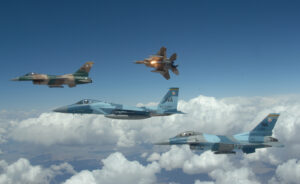Can The Air Force Innovate? Snake Clark And Buzz Moseley
Posted on
Many observers of the US military would agree that the best ideas are often not to be found among its generals and admirals. If you want to find good and disruptive ideas in the military, you get to know the majors and colonels.
One of the standard comments you’ll hear about smart colonels is that they were pushed out before they could win a star, precisely because they had a really good idea or two and were thus far too disruptive of the status quo.
The Army had Col. Doug MacGregor, whose book Breaking The Phalanx was made required reading by former Chief of Staff Dennis Reimer. The Air Force had Col. Moody Suter and Col. John Boyd. The Navy had Adm. Hyman Rickover, who was sidelined for several years after proposing the then-radical idea of nuclear-powered submarines. And of course, there are all those ordinary soldiers, sailors, Marines and airmen who have come up with great ideas throughout American history.
The choices faced by such military innovators was put pretty well by Boyd, as detailed by his biographer Robert Coram:
“One day you will come to a fork in the road. And you’re going to have to make a decision about what direction you want to go,” [Boyd] raised his hand and pointed. “If you go that way you can be somebody. You will have to make compromises and you will have to turn your back on your friends. But you will be a member of the club and you will get promoted and you will get good assignments.” Then Boyd raised the other hand and pointed another direction. “Or you can go that way and you can do something — something for your country and for your Air Force and for yourself. If you decide to do something, you may not get promoted and you may not get the good assignments and you certainly will not be a favorite of your superiors. But you won’t have to compromise yourself. You will be true to your friends and to yourself. And your work might make a difference.”
Suter was one of those who made a difference.
“The Air Force we have today is here because of Moody Suter,” Snake Clark, a key player in bringing the Predator drone to the Air Force from the Army and getting it armed with Hellfire missiles, said yesterday at a gathering about Suter and innovation put on by the Air Force Association’s Mitchell Institute.
Suter’s most important achievement may well be his role as the man who created the Air Force’s famous Red Flag training exercises, highly realistic training designed to ensure American and allied pilots survived their first 10 missions, when a pilot historically faced the greatest chances of being shot down. That certainly wasn’t all Suter helped create, but Red Flag is his best known legacy.
“There were people who tried to get rid of him, tried to mute him,” former Air Force Chief of Staff Gen. Buzz Moseley told the AFA audience. Moseley should know. He served with Suter when they were based at the US air base at Kadena, Japan.
Clark, one of the Air Force’s most respected fixers, painted Suter as one of his own, a man who “knew money, he knew people and he knew programs.” But, Clark noted, “I’m not sure he would succeed in today’s Air Force.”
Let’s hope the smart and disruptive majors and colonels in today’s military services will.
Subscribe to our newsletter
Promotions, new products and sales. Directly to your inbox.

